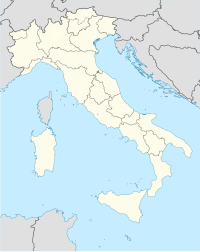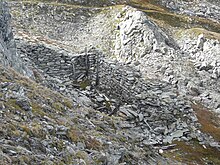White Friday (1916)


- v
- t
- e
1916
- 5th Isonzo
- Asiago (Monte Cengio)
- Gorizia (6th Isonzo) (Doberdò)
- 7th Isonzo
- 8th Isonzo
- 9th Isonzo
- White Friday
1917
- 10th Isonzo
- Flondar
- Ortigara
- 11th Isonzo
- Caporetto (12th Isonzo)
- Pozzuolo
- 1st Piave River
- 1st Monte Grappa
1918
- 2nd Piave River (Capture of Col Moschin)
- 2nd Monte Grappa
- San Matteo
- 3rd Monte Grappa
- Vittorio Veneto
White War (1915–1918)
- Adamello
- Pasubio
- Sentinella Pass
- Marmolada
- Lagazuoi
- Col di Lana
- Tofane
- Monte Cristallo
- Monte Piana
- Tre Cime di Lavaredo
- Monte Paterno
White Friday occurred during the Italian front of World War I. The most significant avalanche struck the Austro-Hungarian barracks on Mount Marmolada, killing 270 soldiers. Other avalanches on the same day would strike Italian and other Austro-Hungarian positions, killing hundreds. According to some reports, both sides deliberately fired shells into the weakened snowpacks in an attempt to bury the other side.
An accurate estimation of the number of casualties from the White Friday avalanches is not available; historical documents suggest at least 2,000 soldier deaths and a few dozen civilians.[1]
Though the occurrence of avalanches in the Dolomites Mountains took place on a Wednesday in 1916, the term "White Friday" was used to coin the disastrous day, and the event is commemorated every year on 13 December, which is also marked by Saint Lucy's Day, a commemorative religious holiday practiced by the majority of Italian Catholics.[2]
Gran Poz summit Avalanches
The Austro-Hungarian Kaiserschützen military barracks were built on the Gran Poz summit (approximately 11,000 ft, approximately 3.35km, above sea level) of Mount Marmolada. The wooden barracks were built in August of the summer of 1916, to house the men of the 1st Battalion of the Imperial Rifle Regiment Nr.III (1.Btl. KschRgt.III). The location of the barracks was planned to be well situated to protect it from Italian attack and provide a defense atop the contested Mount Marmolada. The barracks was placed along rock cliffs to protect it from direct enemy fire and the location was out of high-angle mortar range.[3]
During the winter of 1916, heavy snowfall and a sudden thaw in the Alps created conditions ripe for avalanches. From the beginning of December, the snow pile-up was recorded at 8–12 metres (26–39 ft) atop the summit. The Austro-Hungarian commander of the 1. Btl. KschRgt.III, Captain Rudolf Schmid, noticed the imminent danger his company faced. Out of fear his position would be soon untenable, Capt. Schmid wrote a request to his superior, Field Marshal Lieutenant Ludwig Goiginger of the 60th Infantry Division. The appeal was ultimately turned down to vacate the base atop Gran Poz summit.[4] In the eight days before the avalanche, additional heavy snowfall disrupted telephone lines of communication and left each outpost stranded with a lack of supplies.[5]

On 13 December 1916, at 5:30 a.m., over 200,000 tons (approx. 1 million cubic metres) of snow and ice plunged down the mountainside directly onto the barracks. The wooden buildings packed with soldiers, collapsed under the weight of the avalanche, crushing the occupants. Of the 321 troops present, 229 were Kaiserschützen mountain infantry and 102 were Bosnians from a support column. Only a few were pulled to safety while 270 were buried alive.[3][6] Only 40 of the bodies were ever recovered from the pileup. Among those who survived was Captain Schmid along with his aide, who escaped slightly injured.[5]
Val Ciampi d'Arei Avalanches
On the night of 13 December, an avalanche struck an Italian division of the 7th Alpini, overrunning their mountain barracks. The Italians called the disastrous day La Santa Lucia Nera after Saint Lucia.[6]
Aftermath
In the aftermath of White Friday, 10,000 soldiers on all sides were killed in December from avalanches. Altogether, it constituted the greatest number of deaths caused by snow/ice debris from avalanches in history. When including all avalanche-related deaths (this includes mud and rock slides triggered subsequently by an avalanche), White Friday is the second-worst avalanche-related disaster recorded, after the 1970 Huascarán avalanche.[7]
See also
Media
Literature
- Die Marmolata. Vol. I (i ed.). Wein: Kaiserschützbund. 1956.
Swedish heavy metal band Sabaton. wrote and performed the song “Soldier of Heaven” on their 2022 album The War to End all Wars album paying tribute to and commemorating the soldiers that died during the avalanche.
References
- ^ "December 1916: Deadly wartime weather". University of Bern. Retrieved 2 February 2018.
- ^ Minghetti, Tullio (1 January 1940). I figli dei Monti pallidi: vita di guerra di un irredento trentino (in Italian). Legione trentina.
- ^ a b "Soldiers perish in avalanche as World War I rages - Dec 13, 1916 - HISTORY.com". HISTORY.com. Retrieved 22 January 2016.
- ^ "Österreichischer Heeresbergführerverband". www.heeresbergfuehrer.at. Retrieved 23 January 2016.
- ^ a b "Das Gipfelbuch der Punta di Penia (Marmolata)". www.dolomitenfreunde.at. Retrieved 23 January 2016.
- ^ a b Durschmied, Erik (1 January 2001). The Weather Factor: How Nature Has Changed History. Arcade Publishing. ISBN 9781559705585.
- ^ "Rock and Snow Avalanche, Mount Huascaran, Peru". NOAA National Centers for Environmental Information. Retrieved 3 February 2016.











